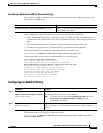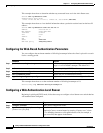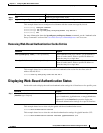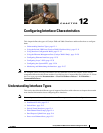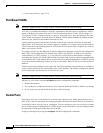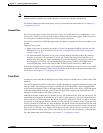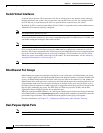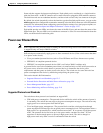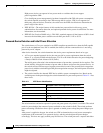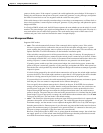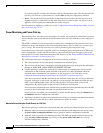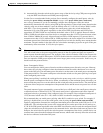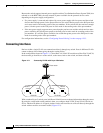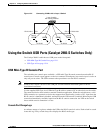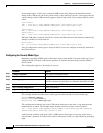
12-5
Catalyst 2960 and 2960-S Switch Software Configuration Guide
OL-8603-09
Chapter 12 Configuring Interface Characteristics
Understanding Interface Types
Some switches support dual-purpose uplink ports. Each uplink port is considered as a single interface
with dual front ends—an RJ-45 connector and a small form-factor pluggable (SFP) module connector.
The dual front ends are not redundant interfaces, and the switch activates only one connector of the pair.
By default, the switch dynamically selects the interface type that first links up. However, you can use the
media-type interface configuration command to manually select the RJ-45 connector or the SFP module
connector. For information about configuring speed and duplex settings for a dual-purpose uplink, see
the “Setting the Interface Speed and Duplex Parameters” section on page 12-27.
Each uplink port has two LEDs: one shows the status of the RJ-45 port, and one shows the status of the
SFP module port. The port LED is on for whichever connector is active. For more information about the
LEDs, see the hardware installation guide.
Power over Ethernet Ports
Note PoE is supported only when the switch is running the LAN base image. Power over Ethernet Plus (PoE+)
is supported only on Catalyst 2960-S switches.
PoE switch ports automatically supply power to these connected devices (if the switch senses that there
is no power on the circuit):
• Cisco pre-standard powered devices (such as Cisco IP Phones and Cisco Aironet access points)
• IEEE 802.3 af-compliant powered devices
• IEEE 802.3 at-compliant powered devices (PoE+ on Catalyst 2960-S switches only)
A powered device can receive redundant power when it is connected only to a PoE switch port and to an
AC power source. After the switch detects a powered device, it determines the device power
requirements and then grants or denies power to the device. The switch can also sense the real-time
power consumption of the device by monitoring and policing the power usage.
This section has this PoE information:
• Supported Protocols and Standards, page 12-5
• Powered-Device Detection and Initial Power Allocation, page 12-6
• Power Management Modes, page 12-7
• Power Monitoring and Power Policing, page 12-8
Supported Protocols and Standards
The switch uses these protocols and standards to support PoE:
• CDP with power consumption—The powered device notifies the switch of the amount of power it
is consuming. The switch does not reply to the power-consumption messages. The switch can only
supply power to or remove power from the PoE port.
• Cisco intelligent power management—The powered device and the switch negotiate through
power-negotiation CDP messages for an agreed power-consumption level. The negotiation allows a
high-power Cisco powered device, which consumes more than 7 W, to operate at its highest power
mode. The powered device first boots up in low-power mode, consumes less than 7 W, and
negotiates to obtain enough power to operate in high-power mode. The device changes to
high-power mode only when it receives confirmation from the switch.



